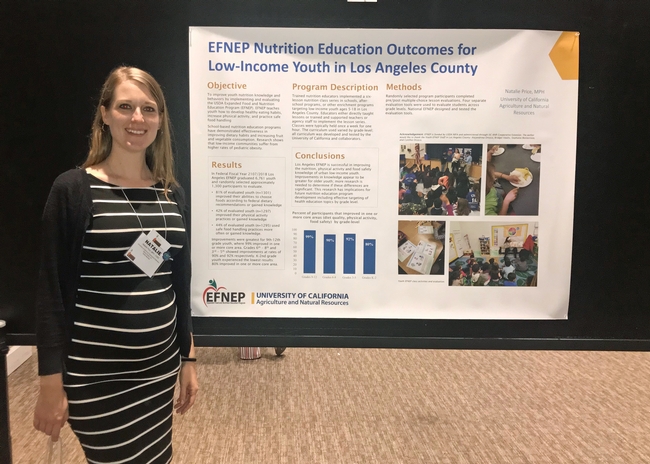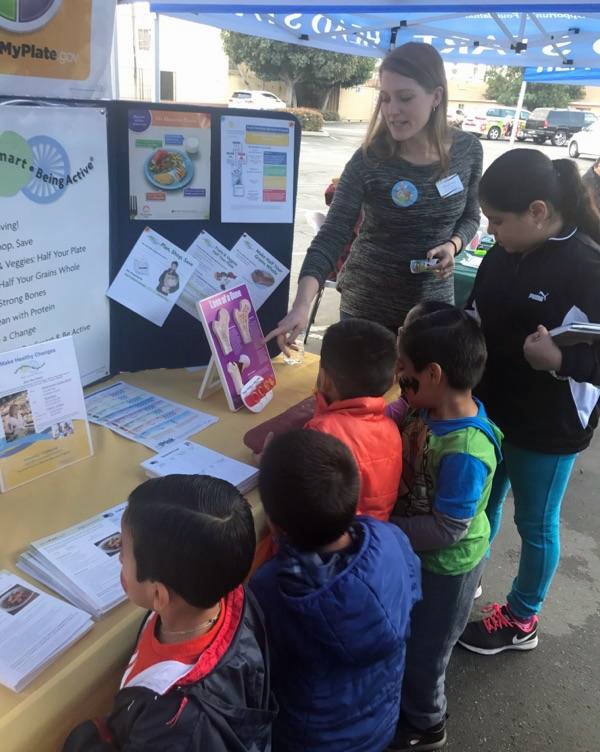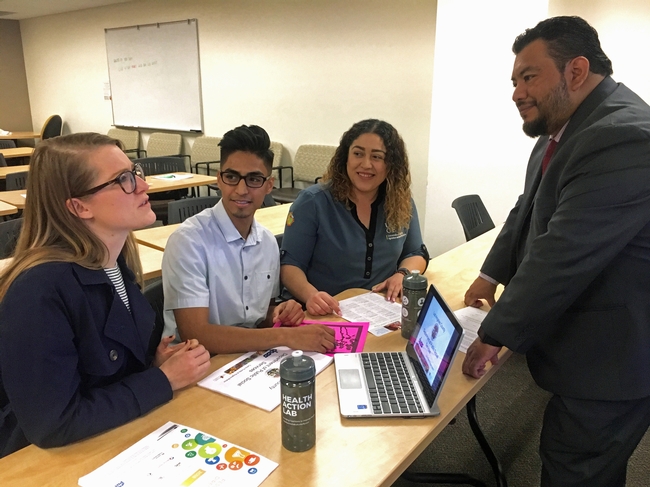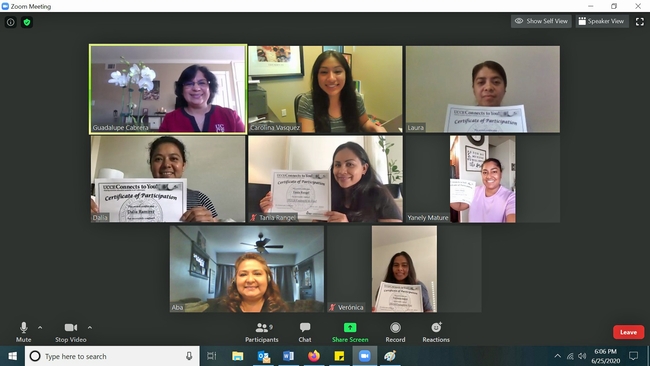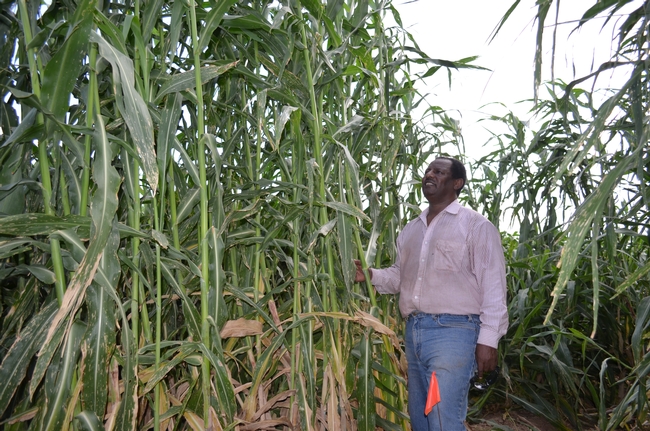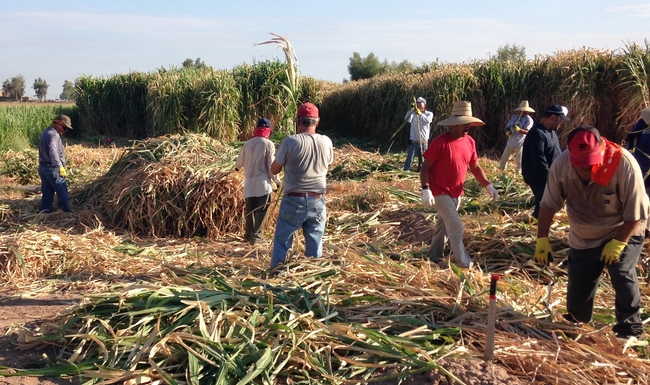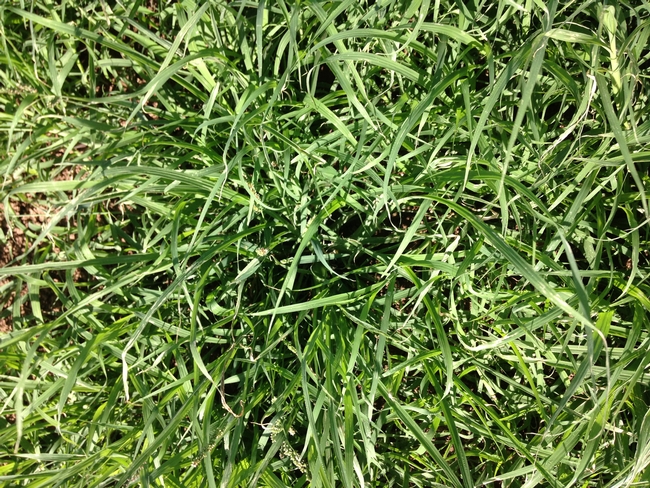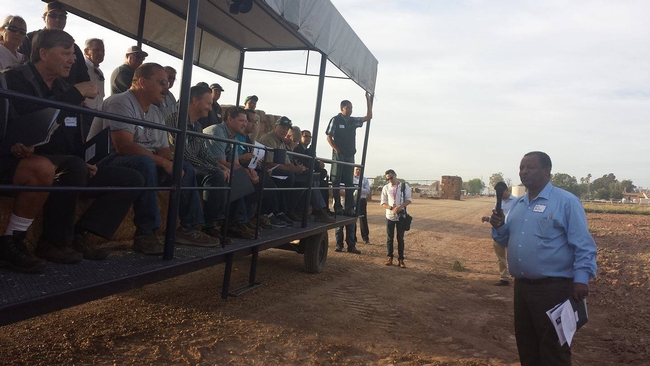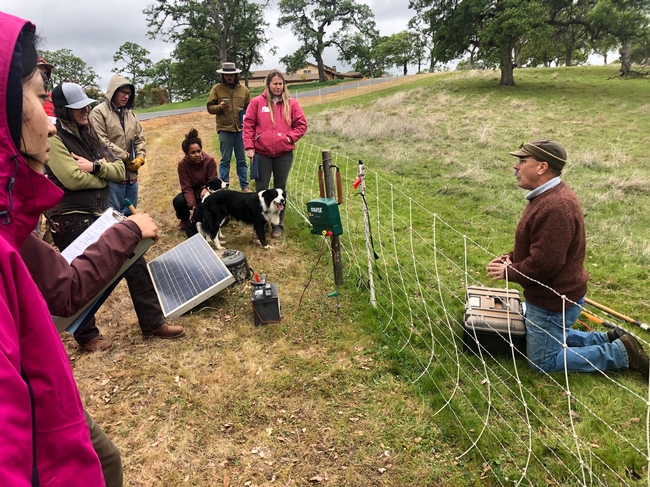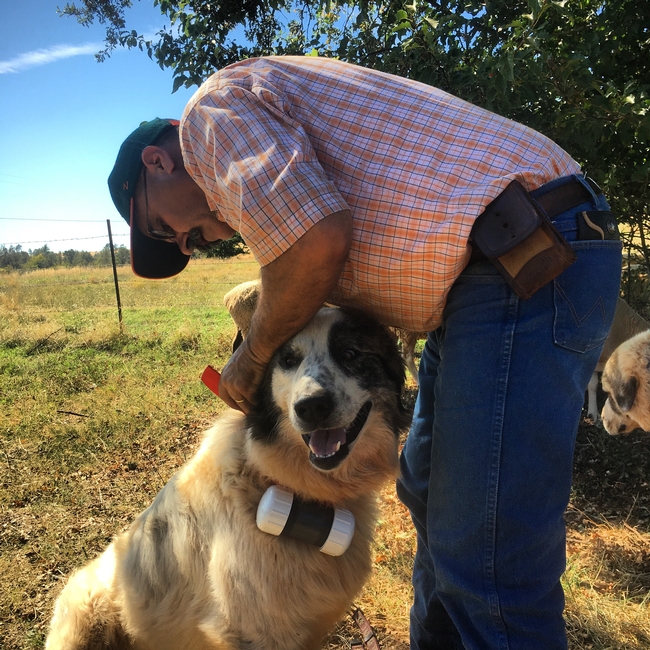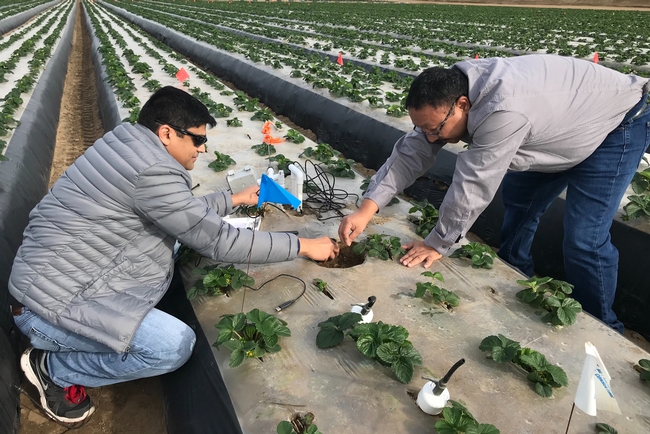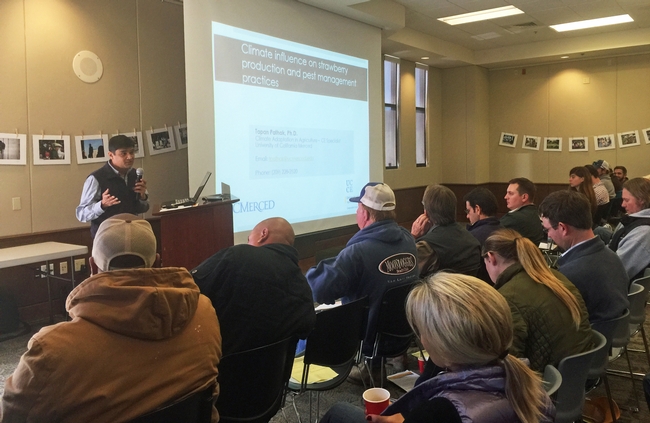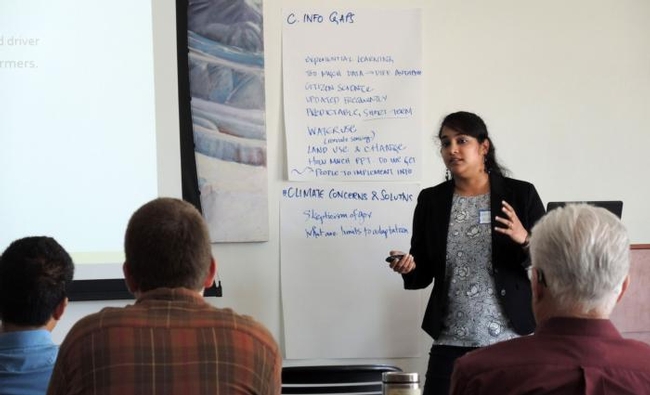
Posts Tagged: public value
UCCE advisor works towards food security in Los Angeles and Orange counties
This is one of a series of stories featuring a sampling of UC ANR academics whose work exemplifies the public value UC ANR brings to California.
As an international development undergraduate at UCLA in the late 2000s, Natalie Price learned of the preventable health conditions prevalent in developing countries and wanted to be part of the solution. The Los Angeles native soon realized, however, that people in her own backyard were also struggling to keep their families healthy and well fed. She decided to join UC Cooperative Extension in Los Angeles and Orange counties to work towards improving food access and affordability for Southern California's most vulnerable residents.
“There's a lot of inequality in terms of pay and access to resources,” said Price, who was named UCCE nutrition, family and consumer sciences advisor in 2017. “I think access to healthy, affordable food is a fundamental human right, especially for kids. It is so important they have reliable food for physical development, mental health and school performance.”
Price earned a master's degree in public health at UCLA and worked for four years with the Los Angeles County Office of Education developing a school nutrition education program and school garden training. In her UCCE post, Price supervises Los Angeles and Orange counties' Expanded Food and Nutrition Education Program, in which nutrition educators visit schools to teach parents and youth to exercise regularly, eat a healthy diet and access resources that make achieving those goals easier.
“In Los Angeles and Orange counties, the cost of living is very high,” Price said. “A lot of families work multiple jobs and still can't comfortably pay their rent and buy the nutritious foods their families need.”
In southeast Los Angeles County, 32.4% of households with incomes under 300% of the Federal Poverty Level are considered food insecure, approximately 79,000 individuals, according to the Los Angeles Department of Public Health. Unable to take on such a daunting task on her own, Price co-chaired a food security symposium in 2019 that brought together 98 people representing 85 direct service organizations interested in taking collective action to serve food-insecure residents of southeast Los Angeles.
Of the symposium participants who completed an evaluation, 65% said they increased their awareness of the food resources available to help food-insecure individuals and families in their area and know how to access them, and 86% increased their understanding of current state and federal policies affecting food-insecure individuals and food assistance programs.
"Information about immigration will be shared with the people of the community, for instance, information about Public Charge,” wrote one participant about a segment of the symposium that outlined a federal policy negatively affecting food insecure immigrant populations. Many immigrants fear they could be denied legal status in the United States if they receive publicly funded services, however, the rule is frequently misunderstood and can lead to immigrants unnecessarily rejecting food assistance.
While Los Angeles and Orange counties are closely connected by freeways and economic activity, the two counties differ. During a needs assessment study in Orange County, Price found that the county was primed to work in food waste prevention. Limiting food waste can boost food security and reduce food waste in landfills, where anaerobic conditions may cause rotting food to emit greenhouse gases that contribute to climate change. Consumer food waste prevention education is a theme Price plans to tie into her work overseeing the UC Master Food Preserver Program. She was planning a food waste prevention campaign on social media when priorities had to be modified due to the worldwide coronavirus outbreak.
“Food insecurity went up dramatically with the shutdown of schools and businesses,” Price said.
She worked with her nutrition education staff to adapt their food security and affordability curriculum to offer it to families online.
“We're doing a lot of outreach and recruiting families to take our EFNEP course. Now we have our online classes up and running,” Price said. “Many parents with school-aged children are becoming familiar with online learning and have a device at home to participate in classes. However, for some, technology can still be a big barrier.”
Price is now working with her UCCE Tulare County colleague Deepa Srivastava to offer online video courses created by partner organization Leas' Pantry to teach families how to maintain a healthy diet while stretching their food dollars.
Former goat herder’s crop research promotes prosperity for Imperial Valley farmers
Oli Bachie, “person of the globe,” researches new desert crops to spur economic growth
While herding goats along dusty roads as a boy growing up in Oromia, Ethiopia, Oli Bachie began striving to improve his economic position in life. His path to a better life passed through the Philippines and Canada before reaching the United States. Now, carrying the mantle of Ph.D., the UC Cooperative Extension farm advisor is doing research to help California farmers take advantage of new opportunities for economic growth.
More than 400 different crops and animals are commercially produced in California. The wide array of agricultural products keep California farmers competitive in the global market. UC Cooperative Extension research into new crops provides growers with information that can lower the risk of trying something new.
Rhodes grass, giant king grass, quinoa and teff are among the crops Bachie has been studying since he joined UC Agriculture and Natural Resources in 2012.
“Giant king grass and Rhodes grass were brought to my attention by companies who wanted me to test their adaptability, biomass yield and nutrition as livestock feed,” Bachie said. “My findings proved that they indeed adapt and produce high biomass and were nutritionally competent or better than many of the low desert grown grass forage crops.”
Two companies provided Bachie with funding to conduct the research. “We do research for industries, companies and growers as long as they provide funding and if we believe that the outcome of the research benefits our clientele and the local economy,” he explained.
Viaspace, a company that grows giant king grass in 11 locations in eight countries on four continents, has relied on Bachie's research for establishing its plantings in the Imperial Valley.
“Oli's research helped us establish basic growing procedures and parameters for Imperial County. It provided the critical information that gave us the confidence to start a larger commercial effort in the desert,” said Haris Basit, vice chairman of Viaspace.
To share information with Imperial Valley growers, Bachie has presented his research results on Rhodes grass varieties at field days and workshops and published in the UCCE Imperial AgBrief newsletter and in the proceedings of the 2019 Western Alfalfa and Forage Crops Symposium. During the COVID-19 pandemic, he has been giving talks via Zoom on Rhodes grass as a new emerging crop, including a zoom workshop organized by the University of Arizona.
“Rhodes grass productivity is well-recognized and is adapted for production not only in the Imperial Valley, but also as far as San Joaquin County and in the state of Arizona,” he said. “A grower in Imperial has started to export Rhodes grass hay to the Middle East. More and more growers within the Imperial Valley and beyond are interested in growing Rhodes grass. I get lots of calls to answer Rhodes grass-related questions. There is now a Rhodes grass seed distributing company in Imperial Valley.”
Giant king grass – a hybrid of elephantgrass and Napier grass, which both grow well as wild plants in Ethiopia – and Rhodes grass are widely grown in Ethiopia. But Bachie didn't study these grasses until he joined UC Cooperative Extension.
Bachie grew up farming with his parents in the rural western part of Oromia, where most coffee and food crops are produced in Ethiopia. “By the way, the name ‘coffee' is derived from a place in Oromia called Kaffaa,” he noted.
“After school in winter, when most farming takes place, I engaged myself in farming,” Bachie said. That afterschool activity piqued his interest in farming and fueled his pursuit of a bachelor's degree in plant sciences from Haromaya University in Ethiopia.
“At that time, when I joined the university, there was only one university in the country,” he said. “I was lucky enough to be one of the few to get university admissions among thousands of high school students.”
In Ethiopia, he worked on a program sponsored by the Ministry of Agriculture and United Nations Food and Agriculture Organization for six years, mostly as a crop protection expert. He studied insects, weeds, pathogens and other crop pests on field crops, vegetables and horticultural crops.
“The experiences I gathered from Ethiopia help me provide services in Imperial County in multidisciplinary pest management – insects, pathogens, weeds and nematodes – at times when we did not have any pest management advisor in Imperial County,” he said. “It has also given me the opportunity to deal with clientele with easy transfer of scientific knowledge.”
Bachie was selected as an FAO fellow to pursue a master's degree in agronomy at the University of the Philippines.
“My area of particular concern then was to look at allelopathy (a chemical inhibition of plant extracts or exudates) as a potential inhibition of weed growth,” Bachie said. His plans to develop a biological weed management approach were disrupted when he graduated with a master's degree and he refused to return to his dictator-led home country.
“Ethiopia was then and is still ruled under a brutal government where educated personnel have little value,” he explained. After graduation, he sought settlement in another country. “That supportive state, which I thank dearly, was Canada.”
After earning a master's degree in forestry from the University of Toronto, Bachie accepted a job at a university teaching network administration and came to the U.S., where he earned a Ph.D. in biological sciences at UC Riverside, “Americanizing not only myself, but also my credential and now I serve UC with full interest and strength,” said Bachie, who holds dual U.S. and Canadian citizenship.
In the spring of 2019, Bachie started comparing grass forage crops (bermudagrass, kleingrass, Rhodes grass and teff) with moringa for livestock feed under low desert conditions. Growers will be able to use the research results to decide which crops will be most profitable for their own operations.
Last summer, Bachie completed a variety trial of quinoa, a grain grown primarily for its edible seeds. He tested the adaptability and grain yield of 35 varieties of quinoa in the heat and biotic stress of the Imperial Valley.
“Of the tested varieties, many tolerated the high heat of the desert and gave promising yields,” said Bachie, who showed the varieties to farmers at an agronomy and irrigation crops field day. “The high grain prices of quinoa in the U.S. and the proof of adaptability and yielding capacity under the low desert condition is expected to attract some growers to grow some quinoa varieties in the Imperial Valley.”
Bachie recently completed a survey of weeds in the county and is planning to publish a handbook titled “Weeds of Imperial County and Management Approaches.”
“While my journey is a huge zigzag and I came up through difficulties, I am very glad that I was able to travel and survive and made myself from a goat herder to an American Ph.D.,” said Bachie, who has also taught biology and environmental science courses part time at Victor Valley and Imperial Valley community colleges, respectively.
“My travel all over the world has enhanced my concepts of human diversity and the affinity to associate and work with people of various backgrounds. To be sure, I call myself a person of the globe.”
UCCE advisor’s breadth of experience and education support ranchers’ economic viability
This is one of a series of stories featuring a sampling of UC ANR academics whose work exemplifies the public value UC ANR brings to California.
Livestock and natural resources advisor Dan Macon came to UC Cooperative Extension three years ago with much more than a formal education in integrated resource management and agricultural and managerial economics.
He had years of hands-on experience running a successful foothill sheep operation, toiling long days and often into the night tending animals, irrigating pastures, training livestock guardian dogs and managing forage.
“I came to this position mid-career,” said Macon, who also accumulated skills working for a family auction company and in various capacities for the California Cattlemen's Association, the California Rangeland Trust and USDA's Natural Resources Conservation Service.
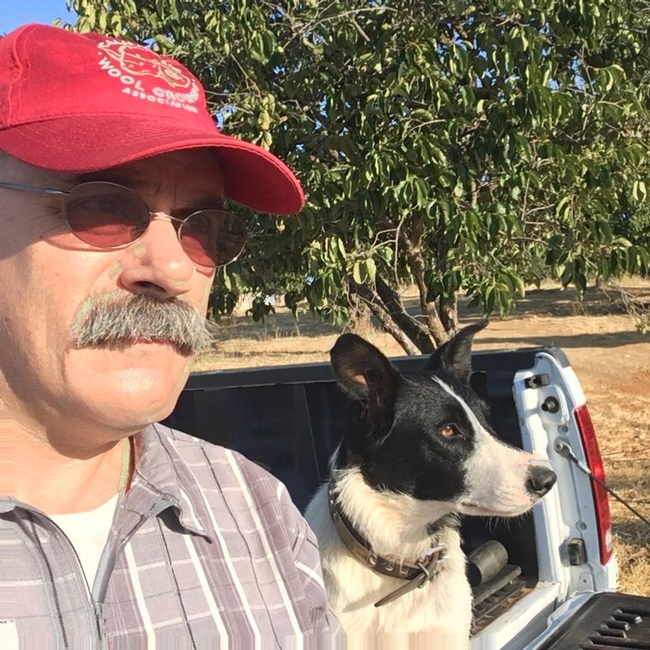
When Macon bought his ranch, he needed help dealing with invasive Himalayan blackberries. He called Roger Ingram, the UCCE livestock and natural resources advisor in Placer and Nevada counties from 1997 to 2017.
“Roger helped me take care of the problem,” Macon said. “Following his recommendation, I bought goats and they grazed the blackberries into submission. Now the grass can out-compete the invasive plants. We've turned the area into grassland.”
Macon began volunteering for UC Cooperative Extension by teaching fellow ranchers about his experiences raising sheep, managing rangeland and raising and training livestock guardian dogs. Macon was a presenter at Ingram's annual California Multi-Species Browsing Academy.
“I finally recognized that the parts of my earlier jobs that I most enjoyed involved things I'd be doing on a daily basis as a farm advisor – teaching and research,” Macon said. He earned a master's degree from Colorado State University and applied to succeed Ingram after his retirement. Macon also took on the role in Sutter and Yuba counties, succeeding Glenn Nader.
Livestock production in the Sierra Nevada foothills ranks among the top five agricultural commodities. Economic viability is a major issue. Macon's research and extension program is focused on ranch economics and business management, drought resilience, predator-livestock coexistence and irrigated pasture management.
At the UC Sierra Foothill Research and Extension Center in Browns Valley, Macon is conducting research that will help ranchers make decisions about maintaining a cattle herd when faced with impending drought. Even when the weather forecast is dry and forage isn't growing at a sufficient pace, ranchers can be reluctant to sell off their cattle.
“Science tells us you shouldn't try to feed your way out of a drought,” Macon said. “Ranchers want everything to stay the same. They want to maintain their genetic potential and keep cows that are familiar with the area.”
The research will compare cows weaned on a traditional weaning schedule with others that are weaned early.
“The cattle will be out on the range from March to early September under different parameters,” Macon said. “We're also tying in economics, the value of genetic potential and the value of having cows who know the landscape.”
Macon is securing funding to conduct research on livestock guardian dogs in different production settings. Using low-cost GPS technology developed at New Mexico State University, Macon plans to study the relationship between dogs, predators and livestock in terms of space and time.
“One unknown is whether they displace predators or disrupt predatory behavior,” Macon said.
Macon uses livestock guardian dogs on his ranch and will be able to draw on his own experiences in designing the study. He recently wrote a fact sheet on guardian dog selection with UCCE human-wildlife interaction advisor Carolyn Whitesell.
“We've had great success with our guardian dogs,” he said. “But not everyone has that level of success. Using scientific tools like remote sensing and GPS technology will give us more details about wildlife-guardian dog-livestock interactions.”
During this year's shelter-in-place, Macon has become more creative in reaching out with scientific ranching information. He and large-scale sheep producer Ryan Mahoney of Rio Vista created a weekly podcast, “Sheep Stuff Ewe Should Know.” Early episodes cover such topics as risk management, the effects of COVID-19 on the sheep industry and livestock guardian dogs. The podcast is available on Spotify and other mobile podcast apps.
Macon developed a new bi-weekly webinar series, “Working Rangeland Wednesday,” with UCCE specialist Leslie Roche and UC Davis graduate student Grace Woodmansee. Recordings are posted on YouTube.
Traditional, one-on-one farm calls are also a part of Macon's extension program. He conducts five or six a month. Even so, the COVID-19 pandemic prompted Macon to begin remote advising. Soon after Gov. Newsom's shelter-in-place order was issued, Macon got a call from a woman whose ewes had recently given birth.
“She thought the lambs weren't doing well and wondered what she could do,” Macon said. “We both had Facetime, so I asked her to show me what the sheep looked like. I was able to assure her that things were normal and suggested bottle feeding. I talked to her several times over the next couple of days, and she was able to save the lambs.”
Most queries from local ranchers center on pasture or grass management, species composition, fencing, paddock design and animal husbandry. Last year, ranchers called with blue oaks suddenly and inexplicably dying on their land.
“The trees had no visible injuries. Ranchers were wondering if it was a lingering effect of drought or due to habitat fragmentation,” Macon said.
Macon contacted UC Cooperative Extension plant pathology specialist Matteo Garbelotto, a UC Berkeley-based tree disease expert. The scientists collected scorched leaves, wood samples and soil near the trunks of the dead or dying trees. They found evidence of fungi Botryosphaeria corticola and B. dothidea in wood chips collected at breast height. However, blue oak is not an official host for the two pathogens in the USDA fungus-host database.
The researchers believe that recent droughts and climate change may be causing an increased and widespread susceptibility of blue oaks or that an unknown pathogen may be increasing the susceptibility of blue oak to the canker disease. The progress made in solving these mysterious blue oak deaths was published in the most recent California Agriculture journal and will be the subject of continuing investigations in the future by Macon and his colleagues.
Climate-change research provides tools for farmers to adapt
This is one of a series of stories featuring a sampling of UC ANR academics whose work exemplifies the public value UC ANR brings to California.
Farmers are already seeing the effects of warmer winter nights and hotter summer days on their crops. Climate change is gradual, but increasing overall temperatures affect many aspects of farming, including where and how crops are grown. Tapan Pathak, University of California Cooperative Extension specialist based at UC Merced, is doing applied research that farmers and ranchers can use to adapt to new conditions created by a variable and changing climate.
“You don't have to shift your practice tomorrow, but if you are thinking of making a 30-year investment, it's important to know what risks there are for planting different crops,” said Pathak, who is based in the Sierra Nevada Research Institute at UC Merced.
Pathak co-chairs the UC Cooperative Extension Climate Change Program Team, whose mission is to increase the capacity among UCCE academics to address climate change concerns with science-based information. Pathak also collaborates with extension professionals from across the western U.S. to do extension events related to climate change adaptation. He works closely with state and federal agencies statewide and growers to identify changes occurring as a result of climate change that affect agriculture. Pathak's research will inform growers' decisions, such as crop variety, planting and harvest dates, extreme heat and frost protection and pest management.
“We are seeing impacts of climate change, that's evident. We have some solutions that are available, but we also need to do more locally relevant crop specific research to make agriculture resilient to climate risks,” Pathak said.
The UCCE scientist was the lead author on an important paper that synthesized the impacts of climate change on California agriculture and offers directions for future research and implementation. The authors concluded that almost all of California's crops, collectively valued at more than $50 billion a year, will be endangered to some degree by rising temperatures and variable weather patterns. The study “Climate Change Trends and Impacts on California Agriculture” was published in Agronomy in 2018.
“I think there's a lot of solutions available and there is also a clear need for adaptation research that include growers' perspectives,” said Pathak, who received a Climate Leadership Award for research from the California Climate & Agriculture Network.
Pathak is also collaborating very closely with UC Davis-based UCCE specialist Daniele Zaccaria, who is leading an international project on evaluating bioclimatic indices and developing the index that is more relevant to irrigated agriculture, which includes scientists from the U.S., Italy, Brazil and Chile.
“A bioclimatic index specific to irrigated agriculture can provide more accurate and valuable agricultural drought information that could be helpful for water resources planning and management decisions,” Pathak said.
Cal AgroClimate
Pathak is developing a web-based decision support system called Cal AgroClimate to help growers make decisions, in partnership with the USDA California Climate Hub director Steven Ostoja. It is being built on the same platform as AgroClimate, which is popular with growers in the Southeast.
Cal AgroClimate translates historical climate data and future projections into a useful decision support system for growers. For example, growers can get extreme heat and frost advisories for the next 10 to 14 days in their region and relevant resources to mitigate risks for their selected crop. It is in the early phase of development and will include a suite of tools based on the needs and priorities identified by UCCE colleagues, growers and the agricultural community in general.
In addition to his work on Cal AgroClimate, Pathak has been conducting research on specific crops.
Tomatoes
In a study looking at processing tomato production in the Central Valley, Pathak and UCCE advisor Scott Stoddard found that changing temperatures will likely change the tomato growing season. The scientists looked at processing tomato data starting from 1950 and projections for 2030-2040 to see how the time to maturity is changing.
“In general, the time from emergence to maturity, the timeframe for processing tomatoes in that region is going to shrink by two to three weeks,” said Pathak. “A lot of processors have their timeline for when they need the tomatoes for processing and so when you have this shift in the phenology, that alters the timeframe for when they mature and are ready for the processors. So, there's a whole shift in the management that growers might have to think about in the future.”
Almonds
To identify the climate information almond growers need to take adaptation action, UC Berkeley postdoctoral researcher Kripa Jagannathan, former UCCE advisor David Doll and Pathak interviewed almond growers in the Central Valley. During their conversations with farmers, the researchers clarified that long-term climate projections are not seasonal forecasts or weather forecasts for the next 20 to 30 years. The projections provide information on trends or potential of shifts from historical conditions for making long-term planning decisions.
Pest control is one area where growers will need to make changes. Research by UCCE advisor Jhalendra Rijal and Pathak shows the almond pest navel orangeworm is already extending its life to a fifth generation during a season.
Strawberries
For strawberries, Pathak, UCCE entomology and biologicals advisor Surendra Dara and postdoctoral researcher Mahesh Maskey have developed a model to forecast weekly crop yields based on weather data. “The model was pretty accurate for the Santa Maria region,” Pathak said. “A crop-specific model can be used for labor management not just crop management.”
Because California produces more than 400 agricultural products, adapting to climate change will be more complex than in other states.
UCCE advisor helps dairy operators strike a delicate balance to protect groundwater
Over the last 20 years, UC research has shown that dairies in the San Joaquin and Sacramento valleys are potentially major contributors of nitrate and salts in groundwater. To maintain the quality of this irreplaceable natural resource, the California Water Resources Control Board has ramped up regulations to ensure that diary manure and wastewater application isn't contaminating the aquifer.
UC Cooperative Extension advisor Nick Clark is helping farmers in Fresno, Kings and Tulare counties work through the process and continue producing crops sustainably now and in the future. He was hired in 2015 as the agronomy and nutrient management advisor, a title that reflects the importance of understanding the nutrient cycle and extending information to producers. Three other UCCE advisors are also focused on nutrient management.
Clark is working with dairy farmers who are producing crops to feed their herds, as well as farmers who are producing agronomic crops – such as silage corn, forage sorghum, wheat, triticale, alfalfa, rye and oats – to sell to dairies.
“These farmers operate under the microscope of several agencies for complying with environmental regulations and ordinances,” Clark said. Clark informs growers about the fate of nutrients in plants and soil and rules in place to protect water quality, helping them stay in compliance with government regulations. “Water quality regulations are becoming more strict, more complex and more specific.”
At the same time, some of the finer details about nutrient availability are not yet well understood.
Working closely with Luhdorff and Scalmanini Consulting Engineers, a groundwater engineering and consulting firm, Clark and colleagues have set up research trials on four commercial dairies in the San Joaquin Valley and one semi-research dairy farm to replicate a variety of treatments.
“The idea is to take a much closer look at nitrogen cycling in soil and plants to develop precise data about when plant development allows the crop to take up nitrogen,” Clark said. “The nitrogen application needs to be made so it is in the form plants need when the plants can use it. Otherwise, there is an increased chance it can percolate below the root zone and, eventually, into groundwater.”
Nutrient cycling involves advanced science. The majority of nitrogen content of manure is bound up in an organic molecule, which is not plant available. Plants only take up mineral forms of nitrogen – ammonium or nitrate. When the manure is in the soil, its chemistry changes. Timing by which this happens, Clark said, is extremely variable. Composition of manure, air and soil temperature, soil moisture, and soil microbiota all come into play.
“The research is trying to elicit information for Central Valley dairy farmers as to the best time, best rate and methods of application in order to fertilize crops without losing nitrogen to the groundwater,” Clark said.
Another factor that dairy farmers will have to consider is the implementation of the Sustainable Groundwater Management Act. The law, passed by the California Legislature during the 2011-2016 drought, creates local agencies to monitor groundwater extraction and bring that into balance with groundwater replenishment.
Diary operators are facing these new groundwater quality and quantity regulations at the same time new pressures from climate change are impacting their operations. Clark and his colleagues are also addressing climate change mitigation, adaption and resilience.
“We are looking into alternative feed crops for dairies that might help reduce the amount of irrigation water required to grow crops without sacrificing animal nutrition and milk yield,” Clark said.
One promising option is sorghum. UC Cooperative Extension scientists Jennifer Heguy, Jeffery Dahlberg and Deanne Meyer have been collecting data for a number of years on the crop's nutritional value and impact on milk yield. Another potential feed crop is climate-resilient sugar beets.
“Sugar beets have been used in other parts of the United States and the world as cattle feed, but not as much in the San Joaquin Valley,” Clark said.
He is working with UC Cooperative Extension agronomy specialist Steven Kaffka and UCCE animal science specialist Peter Robinson to refine knowledge about sugar beet production under Central California conditions.
“Sugar beets grow readily in the winter in California, so we can take advantage of winter rainfall and a low irrigation requirement. That may help mitigate climate change impacts,” Clark said.
Climate change mitigation may also be achieved on dairy farms by modifying manure application timing and procedure. Applications of manure to cropland has an impact on emission of nitrous oxide, a greenhouse gas 300 times more potent than carbon dioxide. Reducing the amount of manure applications on cropland and incorporating manure solids into the soil may be ways for dairy farmers to reduce their facilities' greenhouse gas emissions.
“We need to know a whole lot more to help farmers to stay in compliance and to deal with farming under new constraints,” Clark said. “Our research objectives are never static, because everything is shifting so quickly.”

